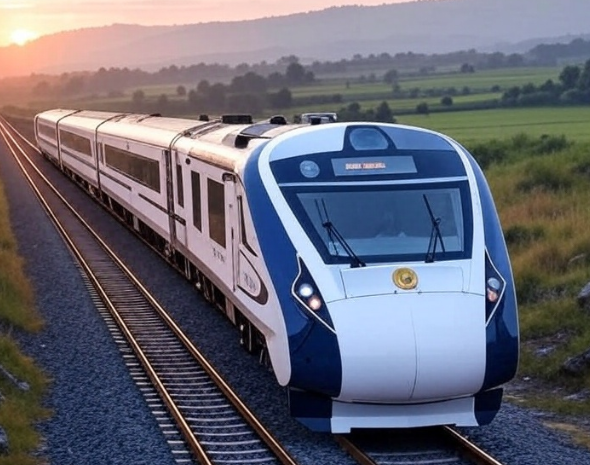
Many people are commenting and asking whether the railway sector is done with its growth phase. But let's be honest here — even I’m a human, and I’ll try to cover each topic one at a time. Today, we’ll focus on a single theme: the railway sector. It’s a sector where many retail investors are actively involved and one which has been generating a lot of questions.
Multiple people are asking about different railway companies like IRFC, IRCTC, Railtel, Ircon, RVNL, and even others like Jupiter Wagons, Concor, and Texmaco Rail. The core question remains the same — what happened to this sector? Why isn't it performing like before? Why has it stopped moving? And has the growth story ended?
Let’s clear one thing — in stock markets, growth is everything. If growth is dead, the sector is dead. But is that true for the railway sector? Let’s ask ourselves honestly — is the railway network in India fully developed? Has work been completed in every village, every city? The answer is no.
We’re not even halfway done. In fact, even saying that 50% of the work is completed would be an overstatement. There is still a lot of work to be done in terms of expansion, electrification, modernization, and networking. There are still several places in India that only have a single railway line, and even more where no railway connectivity exists at all.
Recently, there was a headline about a major region in India getting railway connectivity for the first time. This alone tells us how much development is still pending. When you invest in a company or sector, you're essentially betting on its future business. There’s plenty of business left to be done in Indian railways. The sector is not dead; it is very much alive and filled with potential.
So if growth isn’t the issue, then what is? Why are stocks not moving? Why are they stuck?
That’s not a problem with the sector — that’s your timing. People expect railway stocks to rise every single day, but that’s not how the stock market works. No stock or sector gives daily returns. Everything moves in cycles. Some stocks rally slightly, some give massive returns, some consolidate for years, some fall drastically, and some crash.
Every company and sector goes through five major phases:
small rallies
big rallies
consolidation
decline
extreme crash
No company skips these cycles. Stocks that you saw moving fast recently were probably dormant for two or more years before that. Some of them had fallen by 50% or more during COVID. People who held through that pain and waited patiently have seen good returns now.
So, when you say the sector is not moving — the real issue is timing. Many investors have this habit of buying only when a stock is already rising. When a ₹20 stock becomes ₹200, then they suddenly become interested. But by then, the value is already gone. Timing is everything.
Even the best business can be a bad investment if bought at the wrong time. A ₹10 lakh car is excellent, but if you buy it for ₹20 lakh, it’s not a smart deal. Similarly, a good company bought at a very high price becomes risky. That’s where most investors go wrong — they ignore stage one, the accumulation phase when nobody’s watching. They buy in stage two, when the stock is already in the news, and then get trapped in stage three when profit booking happens.
Here’s how it usually plays out:
In stage one, the stock moves sideways, nobody cares, and that’s the best time to accumulate.
In stage two, it breaks out and goes up fast, and the media starts talking about it.
In stage three, new investors enter hoping for quick profits, and then it consolidates or falls.
Those who bought high now feel stuck and frustrated.
The real problem is not the stock — it's impatience. People expect to buy at any price and make money in a week. But that’s not how investing works. Long-term investing works only when timing is right.
The railway sector is no different. It follows the same pattern. Many railway stocks didn’t move for two years. Then they gave sharp rallies. Now, they are consolidating again. It’s a cycle. No stock gives 10% or 20% moves every day.
Also, many people are wondering why railway stocks were hitting upper circuits earlier and not now. The answer lies in timing again. Those upper circuits usually happen around the budget season. In December and January, when infrastructure and railway allocations are speculated, these stocks rally hard. Budget announcements act as a trigger. But after the budget season is over, everything cools down. That’s a cycle too.
Investors need to understand this seasonality. Just like festivals come once a year, sector rallies often come in specific periods, like budget time.
Now let’s talk about risk. Yes, the railway sector is promising, but it has one major risk — government control. Since most companies in this space are PSUs, any government decision can make or break them. We’ve seen this with IRCTC when the government tried to take away the convenience fee. The stock crashed in a day, and then when the decision was reversed, it rallied again. So, government policy matters a lot.
Moreover, governments change. Even if the ruling party remains, ministers can change, and with them, priorities can shift. This is something investors must be mindful of while investing in public sector companies.
In conclusion, there is no problem with the railway sector. It’s the mindset of the investor that needs to evolve. People expect instant returns without understanding timing, business fundamentals, or cycles. But the truth is:
the railway sector is still growing
India’s infrastructure needs are massive
a lot of work is still pending
these companies will get business in future
patience is necessary
unrealistic expectations lead to disappointment
timing matters more than anything
Buying a stock is easy. Even a 4th standard kid can buy shares if given money. The real task is understanding why you are buying it. If you don’t know the reason, you’re just gambling. If you know the business logic, you’ll have the patience to sit through volatility.
If you panic in corrections and sell at ₹70 what you bought at ₹100, only to see it become ₹1000 later, the fault is not in the stock — the fault is in the lack of planning and discipline.
So yes, railway is a solid sector. But like in cricket, even the best players won’t score centuries every match. Sometimes they’ll get out at zero. Look at the average, look at the long-term story. The investor who bought RVNL at ₹20 and held is sitting on huge gains. But those who bought at ₹1000 hoping for ₹2000 in 2 months are frustrated. The stock market rewards logic, patience, and understanding — not emotion or speed.
Disclaimer:
This blog is for educational purposes only. It does not offer stock recommendations. Please consult a registered financial advisor before investing.




